#NASA Jupiter flyby
Text
"Taken by NASA's Juno spacecraft, this black-and-white photo of the surface of Jupiter's icy moon Europa reveals a curious feature – shaped somewhat like the musical symbol for a quarter note – surrounded by a vast network of linear ridges and dark blotches. It was obtained by Juno's Stellar Reference Unit (SRU) during the spacecraft's Sept. 29, 2022, flyby of Europa."
2 notes
·
View notes
Text

#name:NASA Science Live_ Juno Spacecraft Makes Historic Flybys of Jupiter’s Moons#cr:youtubecom/@NASA
0 notes
Text

Volcanoes on Jupiter's moon Io keep erupting. To investigate, NASA's robotic Juno spacecraft has begun a series of visits to this very strange moon. Io is about the size of Earth's moon, but because of gravitational flexing by Jupiter and other moons, Io's interior gets heated and its surface has become covered with volcanoes. The featured image is from last week's flyby, passing within 12,000 kilometers above the dangerously active world. The surface of Io is covered with sulfur and frozen sulfur dioxide, making it appear yellow, orange and brown. As hoped, Juno flew by just as a volcano was erupting -- with its faint plume visible near the top of the featured image.
Image Credit: NASA, JPL-Caltech, SwRI, MSSS; Processing: Ted Stryk & Fernando García Navarro
2K notes
·
View notes
Photo
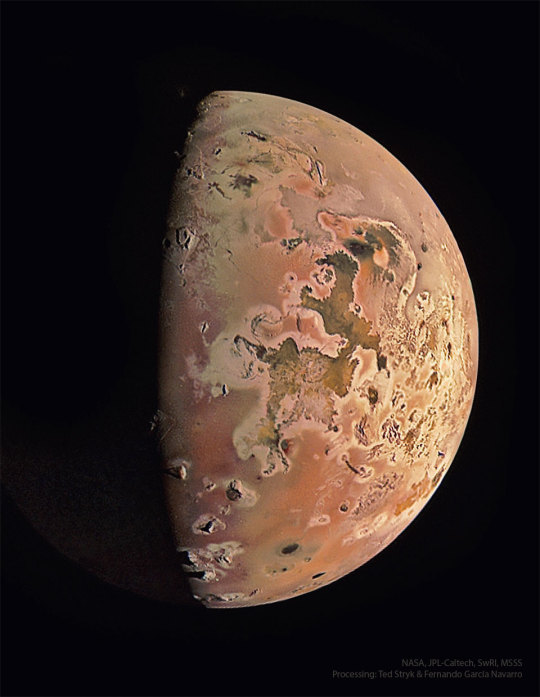
2023 October 23
Moon Io from Spacecraft Juno
Image Credit: NASA, JPL-Caltech, SwRI, MSSS; Processing & Copyright: Ted Stryk & Fernando García Navarro
Explanation: There goes another one! Volcanoes on Jupiter's moon Io keep erupting. To investigate, NASA's robotic Juno spacecraft has begun a series of visits to this very strange moon. Io is about the size of Earth's moon, but because of gravitational flexing by Jupiter and other moons, Io's interior gets heated and its surface has become covered with volcanoes. The featured image is from last week's flyby, passing within 12,000 kilometers above the dangerously active world. The surface of Io is covered with sulfur and frozen sulfur dioxide, making it appear yellow, orange and brown. As hoped, Juno flew by just as a volcano was erupting -- with its faint plume visible near the top of the featured image. Studying Io's volcanoes and plumes helps humanity better understand how Jupiter's complex system of moons, rings, and auroras interact. Juno is scheduled to make two flybys of Io during the coming months that are almost 10 times closer: one in December and another in February 2024.
∞ Source: apod.nasa.gov/apod/ap231023.html
459 notes
·
View notes
Text
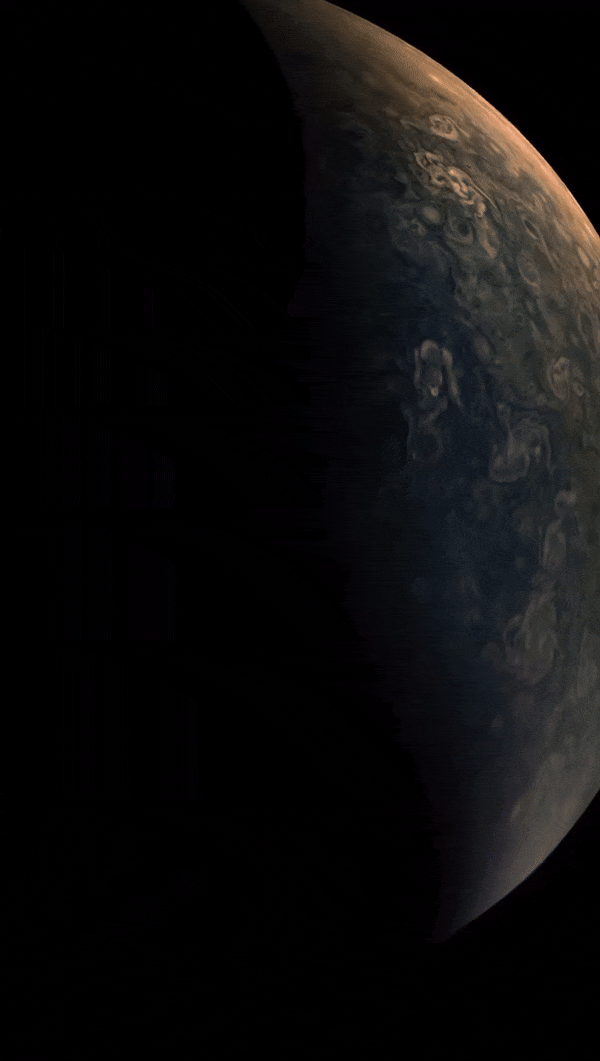
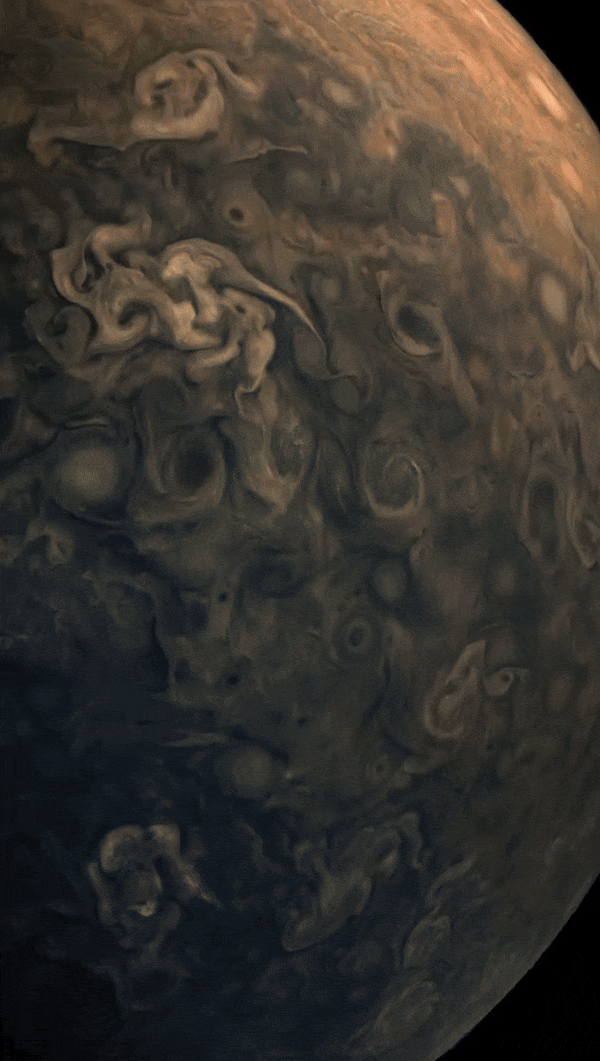



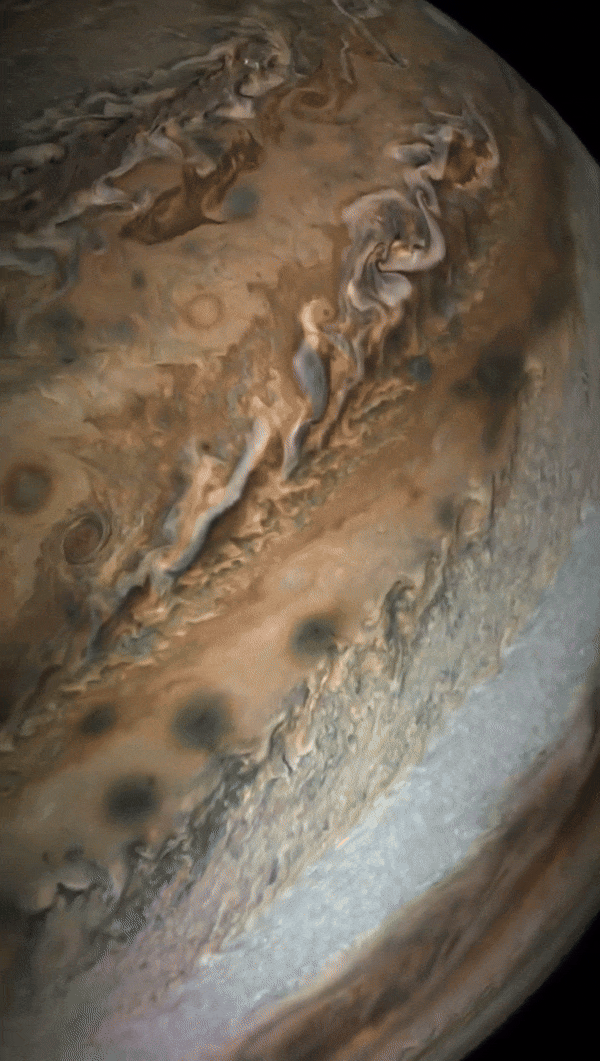
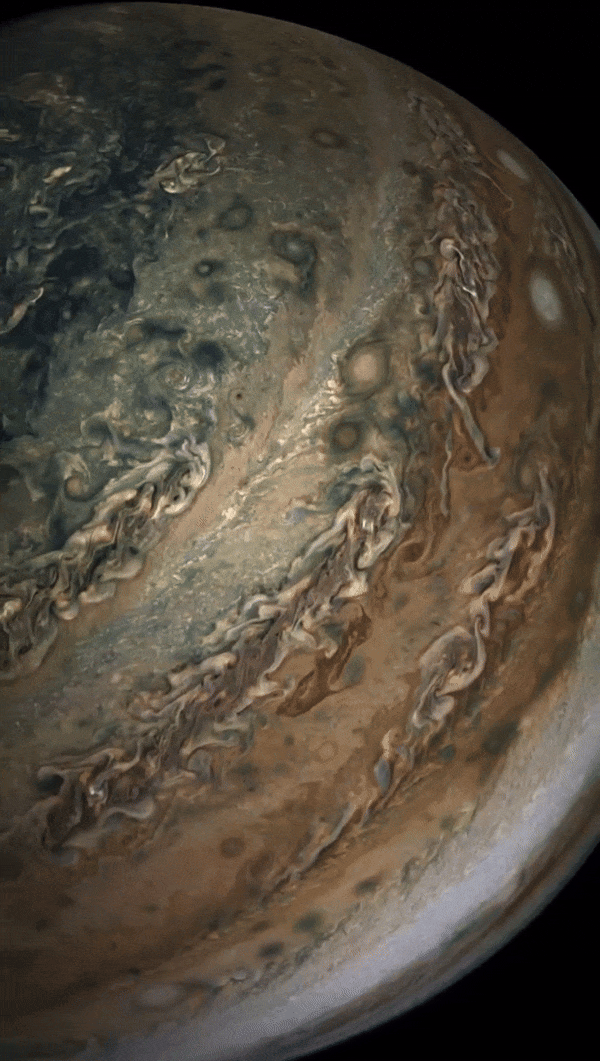

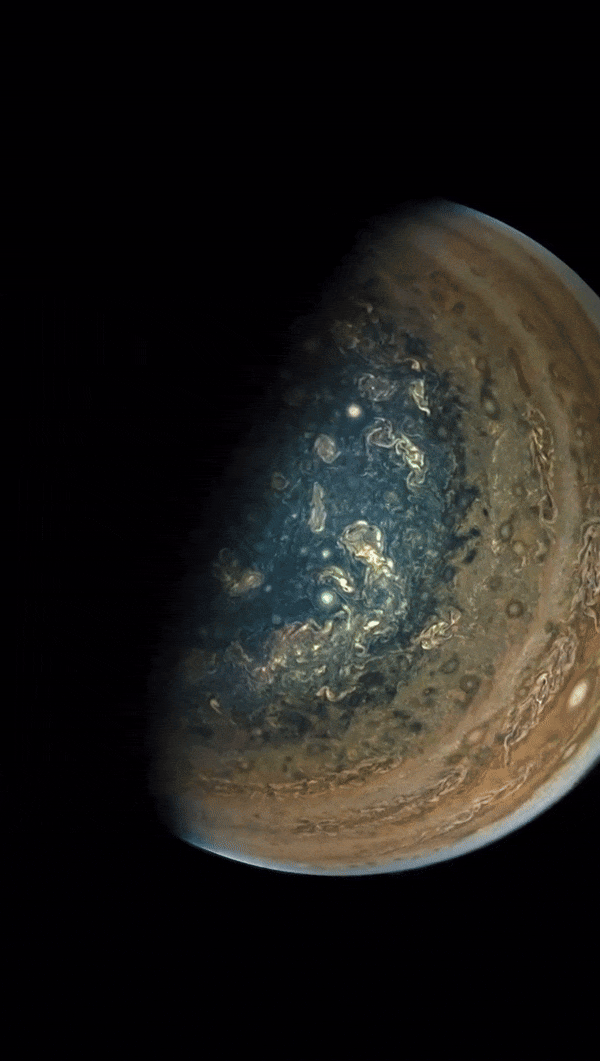
Stunning images of Jupiter captured by the Juno spacecraft during a close flyby in October 2018. (credit: NASA/JPL-Caltech/SwRI/MSSS/Gerald Eichstädt)
393 notes
·
View notes
Text

The sharpest pictures of Jupiter's volcanic moon Io in a generation
NASA's Juno spacecraft has just made the closest flybys of Jupiter's moon Io that any spacecraft has carried out in more than 20 years. An instrument on this spacecraft called "JunoCam" has returned spectacular, high-resolution images—and raw data are now available for you to process, enhance, and investigate.
On Dec. 30, 2023, Juno came within about 930 miles (1,500 kilometers) of the surface of the solar system's most volcanic world. It made a second ultra-close flyby of Io just this week. The second pass went predominantly over the southern hemisphere of Io, while prior flybys have been over the north. There's a lot to see in these photos. There's evidence of an active plume, tall mountain peaks with well-defined shadows, and lava lakes—some with apparent islands.
IMAGE...Jupiter's moon Io, its night side illuminated by reflected sunlight from Jupiter, or "Jupitershine." Credit: NASA/JPL-Caltech/SwRI/MSSS/Emma Wälimäki/CC BY
151 notes
·
View notes
Text

Jupiter’s south pole, captured by NASA’s Juno Spacecraft from about 2,175 miles (3,500 kilometers) above the planet’s cloud tops. This image, taken during the 22nd flyby of the solar-powered spacecraft, revealed a new, massive cyclone on the gas giant’s surface. Juno was launched in 2011 and entered Jupiter’s orbit in 2016, where it is expected to stay until 2025.
Source imagery: NASA
1K notes
·
View notes
Note
You know the more I get into mythology the more I realize how tongue and cheek astronomy is
https://www.tumblr.com/generallemarc/746965719332290560/damnit-tzeentch
I get it because it state the world will end when Apep/Apophis devour the sun. But really nasa?
Also who was the cheeky bastards that decided to named Jupiter moons after it namesake god affairs/victims
The who decided to named the probe that orbit Jupiter after Juno? Like I get why, but seriously
Also found out that our moon proper name is Luna. The sun is called Helios right? Riiiight?
Ahhh NASA, rocket scientists are still nerds first and foremost.
You've also triggered my geek out reflex with this so I'll try to maintain control.

NASA's official deal about it NASA to Launch Sounding Rockets into Moon's Shadow
These are the rockets, they used the same ones in October for the same reason.

They avoid mentioning the inherent pun involved in the name this time, but well, not a secret.

NASA does this kinda often, like you said.
NASA just cracked a great nerd joke 400 years in the making

Also found out that our moon proper name is Luna. The sun is called Helios right? Riiiightt
Helios is the Greek name for the sun, Sol is the Latin, Luna is the Latin for the sun Selēnē is Greek.
Planets are officially named after Roman deities, they sneak some greek in here and there for stuff which is only fair since Rome stole the Greek pantheon, most polytheistic faiths borrowed from the others but not THAT much.
BONUS FUN
JPL in Pasadena, they're the folks that make all the probes and such, when New Horizons did it's flyby of Pluto they well
Informal Names for Features on Pluto


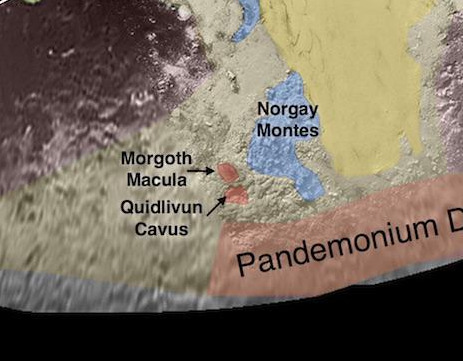

Got Pluto's moon Charon too
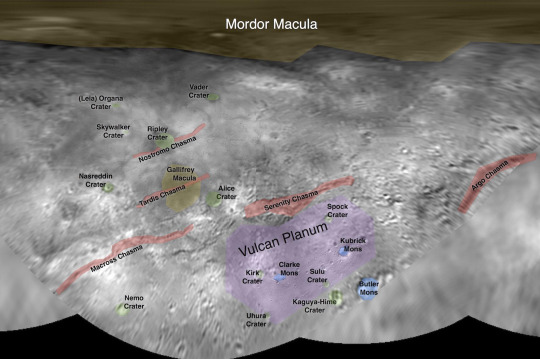
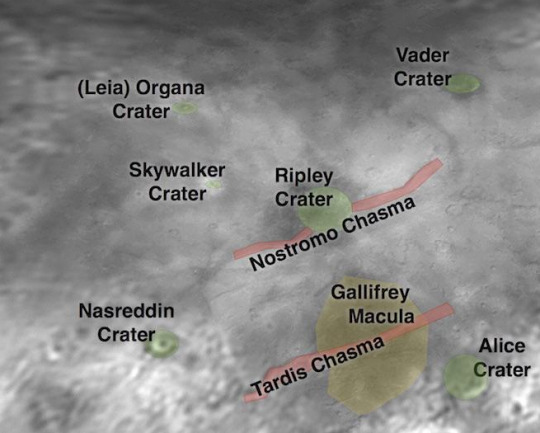

Bless the nerds.
I hope this was contained enough, I could punch out a couple hundred pages nerding out all this stuff but I maintained most of my cool.
48 notes
·
View notes
Text
Jupiter's Io stands apart from the solar system's other moons, with its numerous volcanoes and its surface dominated by lava flows. Io's surface volcanism was confirmed in 1979 when the Voyager spacecraft imaged it, but its volcanic nature isn't duplicated anywhere else in our system. Tidal heating is behind the moon's eruptive nature, driven by Jupiter's powerful gravity, and by resonance with other moons. But is there a magma ocean inside Io?
A final answer to that question has been elusive, but new research supports the idea of a magma ocean.
NASA's Juno mission has shifted its focus from Jupiter to the gas giant's moons, beginning with the volcanic Io. It's flybys are getting increasingly closer to the unique moon, and the decreasing distance is giving the spacecraft a better and better look. It's identified 266 active volcanoes, and together, they're evidence of a vast global ocean of magma according to new research.
Continue Reading.
114 notes
·
View notes
Text

Boom!! There goes another one! One of Jupiters many moons, Io, is about the size of Earth's moon, but its surface is full of volcanic activity. This is due to gravitational flexing by Jupiter and other moons. The process heats the moons interior, covering the surface with volcanoes. The featured image is from NASA’s robotic June spacecrafts fly by last week, passing within 12,000 kilometers above the dangerously active world. The surface of Io is covered with sulfur and frozen sulfur dioxide, making it appear yellow, orange and brown. As hoped, Juno flew by just as a volcano was erupting -- with its faint plume visible near the top of the featured image. Studying Io's volcanoes and plumes helps scientists better understand how Jupiter's complex system of moons, rings, and auroras interact. Juno is scheduled to make two flybys of Io during the coming months that are almost 10 times closer: one in December and another in February 2024.
Image credit: NASA
#astronomy#space#science#universe#moon#jupiter#io#jupiter moon#volcano#volcanic activity#erupt#eruption#sulfur#surface#mystery#dangerous#follow#like#reblog#thefirststar#thefirststarr#the first star#the first starr#blog#tumblr#space blog#cool#pretty#colours#wow
86 notes
·
View notes
Text
"well youve had it 6 years that's a good amount of time for that kind of thing to work"
"you should be grateful you got 3 years of use out of that thing, I'm lucky if mine last a year haha"
listen, in 1977 nasa launched the voyager spacecrafts to take advantage of a planetary alignment that takes place every 175 years. These 2 crafts were planned to flyby the outer planets of our solar system and gather data on them to send back to us. Voyager 2 launched first on the 20th of August despite its name because it was planned to reach our gas giants after its counterpart voyager 1, which launched a little later on the 5th of September.
The voyager mission was planned to end 12 years later in 1989. In that time, voyager 1 and 2 passed by Jupiter, Saturn, Uranus, and Neptune. They discovered new moons, confirmed theories about Saturn's rings, found the first active volcanoes found outside the earth, and they take close-up images of planets only seen at that point from telescopes.
On the 25th of August 1989, voyager 2 encounters Neptune, the last planet in our solar system the voyagers will meet. And that was that. End of mission. Now obsolete.
~
Less than 1 year later on valentine's day in 1990 voyager 1 looked back on the planet that had built it and sent with it a world's worth of hopes and dreams and took a picture. We called it the solar system family portrait and in it, we see ourselves. The pale blue dot nestled in the darkness of space
And then commands were sent to shut down their cameras. Preserve fuel.
35 years after launch, in 2012 voyager 1 sent back to us data about interstellar space. The very first manmade object to enter it.
41 years after launch voyager 2 did the same. Still operational, still going. Still sending back to us invaluable data, teaching us about our own solar system and the suns influence in our local bubble of space.
They are expected to continue to operate until the year 2025 - almost 50 whole years after they were launched and 36 years after their mission was supposed to have ended.
48 years of harsh space travel, battered by solar winds, pulled by gravity but fast enough just to escape, pelted by who knows how much space dust and radiation.
And even after that, they still have a purpose. Each craft was given a golden record. A disc filled with human knowledge and knowledge of humans and the planet they live on. Greetings and well-wishes to any prospective extraterrestrial life that could potentially pick it up. Co-ordinates, an invite. Samples of our music, the things we love, sounds of the earth, a story of our world. The surf, the wind, birds and whales, images of a mother, our moon, a sunset. Long after the voyager spacecrafts go dark, probably long after we are gone, they will still be doing their job; educating a species about our very tiny corner of the galaxy.
They are nasa's longest-running operation.
And it was all done using 70s technology.
So excuse me if I want a phone that lasts more than 2 years or a vacuum cleaner that doesn't break down after 6, or god fucking forbid, a refrigerator that will keep my food cold my entire fucking lifetime.
#voyager space#voyager#voyager 1#voyager 2#nasa#planned obsolescence#capitalism#im sorry i took the opportunity to talk a little about the voyagers#they make me emotional okay#i just want things to last without breaking and then being sent to landfill#they did it in the fucking 70s#capitalism is not tenable and i cant afford to keep replacing the gadgets that broke for no other reason than they were built with shit
113 notes
·
View notes
Text
25 notes
·
View notes
Text
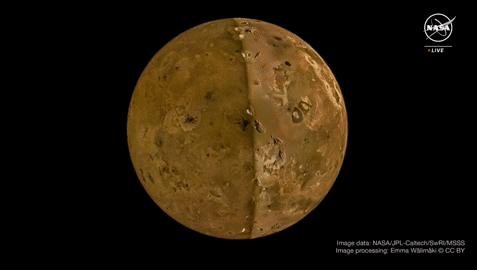
#name:NASA Science Live_ Juno Spacecraft Makes Historic Flybys of Jupiter’s Moons#cr:youtubecom/@NASA
0 notes
Text

High-altitude electrical storms on Jupiter
Juno's sensitive Stellar Reference Unit camera detected unusual lightning flashes on Jupiter's dark side during the spacecraft's close flybys of the planet
📷Image Credit: NASA/JPL-Caltech/SwRI/MSSS/Gerald Eichstädt
📷Image Addition Date: 2020-08-05
609 notes
·
View notes
Photo

2024 March 29
Galileo's Europa
Image Credit: NASA, JPL-Caltech, SETI Institute, Cynthia Phillips, Marty Valenti
Explanation: Looping through the Jovian system in the late 1990s, the Galileo spacecraft recorded stunning views of Europa and uncovered evidence that the moon's icy surface likely hides a deep, global ocean. Galileo's Europa image data has been remastered here, with improved calibrations to produce a color image approximating what the human eye might see. Europa's long curving fractures hint at the subsurface liquid water. The tidal flexing the large moon experiences in its elliptical orbit around Jupiter supplies the energy to keep the ocean liquid. But more tantalizing is the possibility that even in the absence of sunlight that process could also supply the energy to support life, making Europa one of the best places to look for life beyond Earth. The Juno spacecraft currently in Jovian orbit has also made repeated flybys of the water world, returning images along with data exploring Europa's habitability. This October will see the launch of the NASA's Europa Clipper on a voyage of exploration. The spacecraft will make nearly 50 flybys, approaching to within 25 kilometers of Europa's icy surface.
∞ Source: apod.nasa.gov/apod/ap240329.html
91 notes
·
View notes
Link
Pluto with a super-cryovolcano? Why not! All the elements are there, just not in the way we normally think of volcanoes. And, cryovolcanoes are the reason why Pluto’s surface looks the way it does. A recent research paper explains why Pluto could be the home of the latest supervolcano discovery in the Solar System. Planetary scientist Dale Cruikshank and a group of colleagues have been studying a strange feature on Pluto called Kiladze Crater. Its existence raises a lot of questions about what’s happening inside Pluto to create this weird landscape. The researchers recently released a paper exploring this region and offering an explanation for its appearance. Kiladze (circled) is likely a super cryovolcano on Pluto. It contains fault structures and collapse pits that formed through cryovolcanism. The crater (or caldara) shape looks distorted, likely from internal stresses and tectonic shifting. Courtesy New Horizons mission (labeled by author). Interior Action Drives Cryovolcanism The team suggests strongly that Kiladze is a super cryovolcano. Cryovolcanism is the process that sends ice “lava” to the surface of Pluto. We’ve seen it across the outer solar system, in some of the moons of Jupiter, Saturn, Uranus, and Neptune. Like its “sister” form of volcanism here on Earth, some kind of heating melts mantle materials, which can eventually escape to the surface. We’re used to seeing rocky lavas. However, ice and water act as “lava”, too, if conditions are just right. Cryvolcanism at Enceladus, a moon of Saturn. This Cassini narrow-angle camera image looks across the south pole of Enceladus and its geysers of material. Credit: NASA/JPL-Caltech/Space Science Institute And, that’s where Pluto comes in because the conditions are ripe for cryovolcanism. During the New Horizons Pluto flyby in 2015, several features drew the attention of scientists as possible cryovolcanic regions. That included a region called Virgil Fossae. It lies to one side of Sputnik Planitia, a prominent heart-shaped surface feature on Pluto. Kiladze lies at the top of the right “lobe” of the heart and its appearance really had Cruikshank and his colleagues debating its cause. Mapping Kiladze New Horizons acquired both images and spectroscopy of Pluto during its flyby in 2015. One thing that became immediately evident about Kiladze is that there’s water ice scattered around it. That’s unusual because methane and nitrogen ice cover most of the surface of Pluto. So, a patch of water ice surrounding a strange-looking feature seemed unusual. Not only that, but the ice contained an ammonia compound. Some kind of activity brought the water-ammonia mixture up from deep below the surface. But what? A labeled map of Pluto’s surface features, including the Virgil Fossae region (another cryovolcanic region) on the planet. Kiladze lies just off the right “lobe” of Sputnik Planitia and to the left of Sleipnir Fossae in this map. Courtesy New Horizons/NASA. According to Cruikshank, heating is the culprit. “For Pluto, internal heat is also expected to be the driver for volcanism seen in some places at the surface, but we don’t know if there is a subsurface global ocean of water plus various chemicals, or simply pockets of water plus chemicals left over from the time Pluto formed and had a hot interior,” he said. “This is a mystery for the next generation of planetary scientists to solve.” Beyond volcanism, Cruikshank and his team considered the possibility that Kiladze is some kind of distorted impact crater. So, they also examined the surface feature for signs of some alternate origin. Aside from the surface materials, the morphology of the region shows evidence of tectonic activity. There are faulted structures and collapse pits and its overall crater shape is distorted. That doesn’t necessarily point to an impact origin, so what happened at Kiladze? The answer lies in Pluto’s interior structure. Pluto, from the Inside Out Pluto is an icy body wrapped around a rocky core. Much of the “bedrock” of the planet is water ice. A “contaminant” of tholins covers the methane and nitrogen surface ice. Tholins are hydrocarbon compounds created as the gases in the atmosphere and ice on the surface are bombarded by cosmic rays and other radiation. The big job for planetary scientists is to look at all the different surface units on Pluto and figure how how they formed. Cryovolcanism is certainly an important part of that surface “calculus”. Cryovolcanism happens at Pluto because something is heating the interior and sending water ice to the surface. The radioactive decay of elements inside the core is the most obvious explanation for the heating. If so, it might create an ocean of liquid water or pockets of slushy water ice. Some scientists suggest that water ice (or icy slush) surrounds the core. This is a general model of what Pluto’s interior may be like. Courtesy New Horizons mission. Clues on the Surface of Pluto Interestingly, there are places on the surface with patches of water ice, mixed with ammonia. That mixture appears to come from the planet’s interior. Interestingly, ammonia lowers the freezing point of water, which allows it to flow as an icy “magma” through Plutonian cryovolcanoes. Cruikshank pointed out that ammonia it could also be in the form of ammoniated salt or hydrate. It’s not completely clear where it originated. He suggests that it was part of the original mix of material from which Pluto (and most other bodies in the Solar System) condensed some 4.5 billion years ago. Pluto isn’t the only place where ammonia exists, just the most distant (so far). “We’re finding evidence of some kind of ammonia in the spectra of numerous transneptunian objects obtained with the Webb space telescope (not yet published), and it is apparently a ubiquitous component of the planets and small bodies,” he wrote in an email. “It is also a critically important component of prebiotic molecules, as shown in lab studies in which amino acid precursors are synthesized.” Understanding Kiladze on Pluto The Kiladze structure is about 44 kilometers across and lies in a sub-region called Hayabusa Terra on Pluto. In the team paper, it’s described as “a super cryovolcano with a resurgent caldera, having a history of one or more eruptions ejecting a thousand kilometers of cryo-lava and possibly an unknown number of eruptions of smaller scale.” In their paper, Cruikshank’s team discusses the possible causes of Kiladze, including that it stemmed from some ancient impact. However, the presence of fresh ice and the lack of a thick layer of tholins are some of the clues that point more to cryovolcanism both in that region and in Virgil Fossae. A high-resolution image of the Kiladze Crater region on Pluto (left) and a map of the spatial distribution of those surface units. Courtesy Al Emran, NASA/JPL. So, When did Kiladze Form on Pluto? It’s pretty likely that Kiladze is relatively young. It’s certainly not as old as the rest of the surface. The team suggests that its eruptive activity took place over the past few million years. The clues lie in the surface coverings. If Kiladze were old, you’d expect to see some kind of built-up surface layer over the most obvious features. This would be true if a constant rain of organic dust particles from the atmosphere had been settling down over the age of the planet. “We have a good idea of the formation and settling time for smog particles on Pluto,” he pointed out, “and if the Kiladze structure had been sitting there for billions of years, the smog particles would obscure the water ice spectral signature detected by the New Horizons spacecraft in 2015. Hence, the conclusion that it is relatively recently formed.” By “recently”, the team thinks that the exposed patches of water ice may only be a few million years old. And, they may not just be from one large eruption. This super cryovolcano on Pluto has likely erupted many times since it formed. Its very presence—along with recent studies of volcanism at Virgil Fossae—gives future researchers some very important clues as they seek to understand this world’s interior structure. For More Information Kiladze Caldera: A Possible “Supervolcano” on PlutoRecent Cryovolcanism in Virgil Fossae on Pluto The post An Unusual Crater on Pluto Might be a Supervolcano appeared first on Universe Today.
24 notes
·
View notes